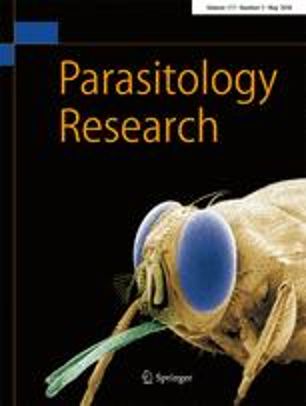Ver ítem
- xmlui.general.dspace_homeCentros e Institutos de InvestigaciónCICVyA. Centro de Investigación en Ciencias Veterinarias y AgronómicasInstituto de Microbiología y Zoología AgrícolaArtículos científicosxmlui.ArtifactBrowser.ItemViewer.trail
- Inicio
- Centros e Institutos de Investigación
- CICVyA. Centro de Investigación en Ciencias Veterinarias y Agronómicas
- Instituto de Microbiología y Zoología Agrícola
- Artículos científicos
- Ver ítem
Biological and molecular features of Nosema rachiplusiae sp. n., a microsporidium isolated from the neotropical moth Rachiplusia nu (Guenée) (Lepidoptera: Noctuidae)
Resumen
Light, electron microscopy and DNA analyses were performed to characterize a microsporidium infecting Rachiplusia nu larvae from a laboratory rearing in Argentina. Diplokaryotic spores were oval and measured 3.61 ± 0.29 × 1.61 ± 0.14 μM (fresh). The spore wall was composed of an electron-dense exospore and an electron-lucent endospore, ca. 30 nm and 100–120 nm thick, respectively. The polar filament was arranged in a single rank of 10–12 coils (typically
[ver mas...]
Light, electron microscopy and DNA analyses were performed to characterize a microsporidium infecting Rachiplusia nu larvae from a laboratory rearing in Argentina. Diplokaryotic spores were oval and measured 3.61 ± 0.29 × 1.61 ± 0.14 μM (fresh). The spore wall was composed of an electron-dense exospore and an electron-lucent endospore, ca. 30 nm and 100–120 nm thick, respectively. The polar filament was arranged in a single rank of 10–12 coils (typically 11). Microsporidian cells were found in the cytoplasm, next to the endoplasmic reticulum (especially the prespore stages) and generally surrounded by electron-lucent spaces. The infection was polyorganotropic; the fat body appeared as the most heavily invaded tissue, followed by tracheal matrix and epidermis. A molecular phylogeny based on the small (SSU) and large subunit (LSU) ribosomal RNA genes clearly placed the new isolate within the “Nosema bombycis clade”. Considering both SSU and LSU concatenated partial sequences, the microsporidium from R. nu showed 99.5% nucleotide similarity with N. bombycis and 99.8% with its closest relative, a microsporidium isolated from Philosamia cynthia. According to its genetic and biological features, the R. nu isolate is proposed as the new species Nosema rachiplusiae sp. n., expanding the limited knowledge on microsporidia associated to endemic South-American moths.
[Cerrar]

Fuente
Parasitology research 117 (5) : 1325–1331. (May 2018)
Fecha
2018-05
Editorial
Springer
ISSN
0932-0113
1432-1955 (Online)
1432-1955 (Online)
Formato
pdf
Tipo de documento
artículo
Palabras Claves
Derechos de acceso
Restringido
 Excepto donde se diga explicitamente, este item se publica bajo la siguiente descripción: Creative Commons Attribution-NonCommercial-ShareAlike 2.5 Unported (CC BY-NC-SA 2.5)
Excepto donde se diga explicitamente, este item se publica bajo la siguiente descripción: Creative Commons Attribution-NonCommercial-ShareAlike 2.5 Unported (CC BY-NC-SA 2.5)

